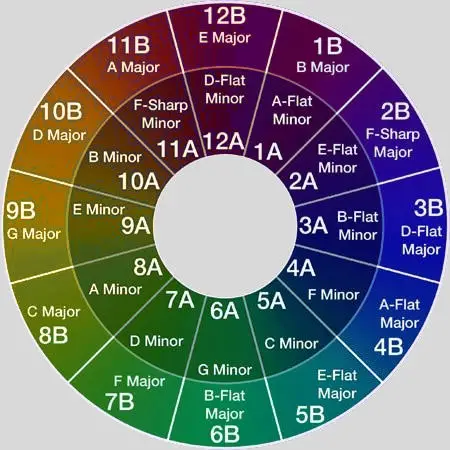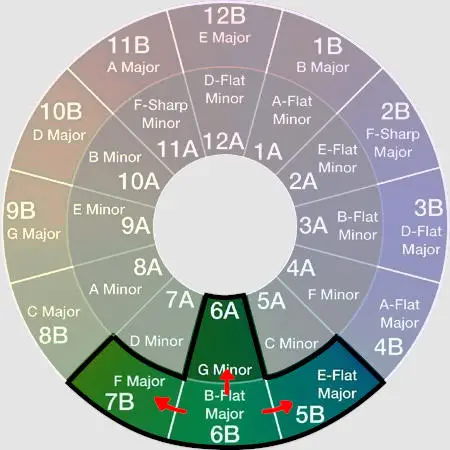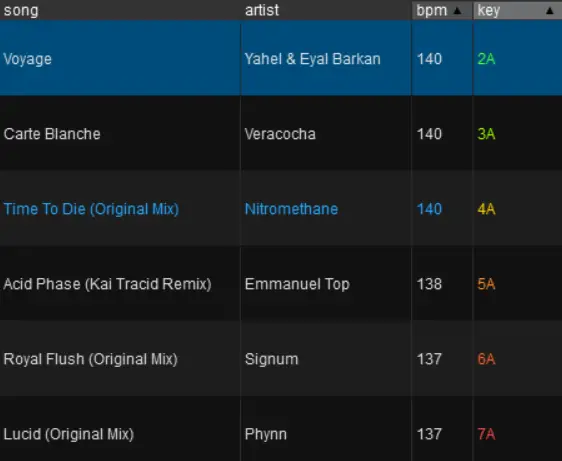If you have been in electronic music for long enough, there is a good probability that you came across the terms “harmonic mixing” or “mix in key”. These are notions that most DJs are familiar with, even more since the rise of digital DJs. To do this, most DJs use the Camelot values along with the Camelot wheel, but what are these?
The Camelot wheel is a tool used by DJs to determine songs that go well together. It is derived from the circle of fifths which categorize songs thanks to their notes. It helps DJs choosing what to play next and avoid clashing tonalities. The Camelot wheel is what DJ use to perform harmonic mixing.
The Camelot wheel and the circle of fifths: twin sisters?
The Camelot wheel is a rebranded circle of fifths with easier key notations. They can be considered the same and use the same purpose. The Camelot uses numbers from 1 to 12 instead of the regular C, D, E, F, G, A, B letters. The ordering on the wheel is also more convenient to use for DJs.
Understanding the circle of fiths
Let’s first focus on what is the circle of fifths. In the theory of music, an octave is decomposed into 12 “pitches”. It corresponds to the notes you all know: C, C#, D, D#, E, F, F#, G, G#, A, A#, B.
All piano nowadays are tuned to fit this rule, the “#” notes correspond to the black keys and the other to the white keys. By going up to 12 “keys” you go up to one octave. By doing that you obtain the same note but with a higher tone. The same applies backward of course. I said pianos to simplify the explanation, but that applies to all western instruments indeed.
All these notes create a system that is called the chromatic scale. In music, using all the notes from the chromatic scale for a given song is very rare. In fact, most song nowadays uses the diatonic scale, a scale that keeps only 7 notes out of the 12.

Then according to the 7 notes you keep, the song is given a key signature. That’s what you hear when someone says “this song is in A major” or “it’s in C minor”. With 7 notes, you can build 24 key signatures corresponding to 12 major scales and 12 minor scales. All the key signatures possible are listed above. These 24 key signatures can be arranged into a circle, the circle of fifths, by following a simple rule.
On the circle of fifths, when you move to the closest key signature on the circle, only one note is changed. For instance, a song in C major has the notes C, D, E, F, G, A, B, and a song in G major has the notes G, A, B, C, D, E, F#. Only the “F” changed here. Because only one note changed, these two key signatures are harmonically compatible. On the circle of fifths, all closest key signatures are harmonically compatible. That’s why it is an interesting concept for mixing.

You have probably noticed that the C major and the A minor share the same notes. Indeed, the A minor is what is called the relative minor of C major. While they share the same notes, their key signature remains different. This is mainly due to the fact they don’t use the same combination of chords in their song structure. Despite using the same notes, a major song will sound happy whereas a minor song will sound sad.
While mixing, changing from a major to its relative minor is a good technique to change the mood. It will work because all the notes composing the song remain identical even if the mood changes drastically.

The Camelot wheel transformation
The Camelot wheel is easier to use than the circle of fifths because the numbers follow each other on the circle. The relative major-minor signatures are also highlighted by a letter change. For instance, 6A is the relative minor of 6B. All “A” keys are minors, whereas the “B” keys are majors.
The Camelot wheel is easier to use for DJs because the compatible key signatures follow each other either by their number or letter. That’s not the case on the circle of fifths for which you need to remember every combination by heart.
How to use the Camelot wheel
To use the Camelot wheel, one can refer to the “T-method”. It consists of mixing keys immediately adjacent to each other on the wheel. These are the keys that are the most harmonically compatible. To give an energy boost, you can also add +2 from the Camelot value you are at.

In the example above, from a 6B song, the next one can be 6B, 6A, 7B, 5B (T-method), or 8B (energy boost). Notice that you can mix a song in the exact same key (here 6B). That makes sense since they use the exact same notes!
You may find additional “rules” online but many of them are false because they don’t have any music grounding. The only additional rule that may make sense is the “-5” in my opinion. Indeed, it corresponds by shifting up all the notes by one semi-tone. This will work great as an energy boost.
Now that you understand the principles, you also need to know what key signature your songs have. This is where software comes in. Most DJ software nowadays has a key detection algorithm, you can thus use them or use an external application such as “Mixed In Key”.
In short, this is how to use the Camelot wheel:
- Analyze your tracks in your favorite DJ software.
- Sort them by keys.
- Put the key lock on all decks.
- Chose the next song either by the “T-method” or by doing +2.
- Trust your ears.

Please note that the Camelot wheel does not do everything. That’s why I wrote “Trust your ears” as the 5th bullet point. First, the key detection algorithms are not always right. There can be many reasons behind it. For instance, a song may not be in the diatonic scale or it can have a changing key signature from start to end. In such cases, the algorithm would be wrong. It is also important to put the key lock on. Indeed, speeding or slowing a song will change its key signature without it.
It is also crucial to find the right moment to mix songs. Songs selected by the “T-method” can be mixed at almost any point in the songs. For instance, you can mix a vocal of song A with the instrumental of song B, that would sound great because they are harmonically compatible.
However, when doing an energy boost, the tonalities are not fully compatible. In that case, it’s better to stick to intros/outros or know your song’s phrasing very well. Indeed, an energy boost works better when the instrumental of Song B starts when the one from Song A stops (no overlapping).
Last but not least, mixing only in key can lead to very boring sets. Indeed, though it leads to awesome transitions, all the songs will have the same tonalities. Therefore it can be boring if the same key signature is kept too long. That’s why it’s important from time to time to jump to a completely different key so it’s less monotonous. In that case, make sure not to overlap instrumentals so the harmonics do not clash.
The meaning of the Camelot wheel in music
The Camelot wheel is a translation of the circle of fifths which is used a lot in music. Each square represents a key signature, also called scale. Adjacent squares have 6 notes out of 7 in common. This explains why transitioning from adjacent key signatures sounds so great, they are very similar!
Knowing key signatures is also an interesting aspect. Indeed, key signatures are associated with particular feelings like love, death, melancholy, etc. If a musical composer wants to create a childish song, he would likely write in C Major (8B). A song about death would likely be in Ab Major (4B), melancholy in D minor (7A), etc. At least that’s one of the influencing factors. For a DJ, knowing what kind of mood a key gives can also be interesting to build a story in your sets.
The circle of fifths is also used a lot in chord progressions. As you may know, many famous pop songs use the same four chords: I, IV, V, vi. And you know what? It shapes the same “T” on the circle that DJ uses to mix in key! Let’s say you write a song in G Major. The I chord is G, the IV C, the V D, and the vi Em. You have 4 chords to play on your instrument that would sound harmonically great together. That’s the power of the circle of fifths!
Here is a sketch that illustrates how famous songs always use these 4 chords:
The equivalence between Camelot values and music keys.
As you understood, every Camelot values corresponds to a key signature or scale of the circle of fifths. For instance:
Camelot value 8B is C major.
Camelot value 9A is E minor.
Here is a table showing the corresponding value between Camelot keys, music scales, and open keys:
| Camelot key value | Music scale key | Open key |
|---|---|---|
| 8B | C Major | 1d |
| 9B | G Major | 2d |
| 10B | D Major | 3d |
| 11B | A Major | 4d |
| 12B | E Major | 5d |
| 1B | B Major | 6d |
| 2B | F# Major | 7d |
| 3B | Db Major | 8d |
| 4B | Ab Major | 9d |
| 5B | Eb Major | 10d |
| 6B | Bb Major | 11d |
| 7B | F Major | 12d |
| 8A | A minor | 1m |
| 9A | E minor | 2m |
| 10A | B minor | 3m |
| 11A | F# minor | 4m |
| 12A | C# minor | 5m |
| 1A | G# minor | 6m |
| 2A | D# minor | 7m |
| 3A | A# minor | 8m |
| 4A | F minor | 9m |
| 5A | C minor | 10m |
| 6A | G minor | 11m |
| 7A | D minor | 12m |
